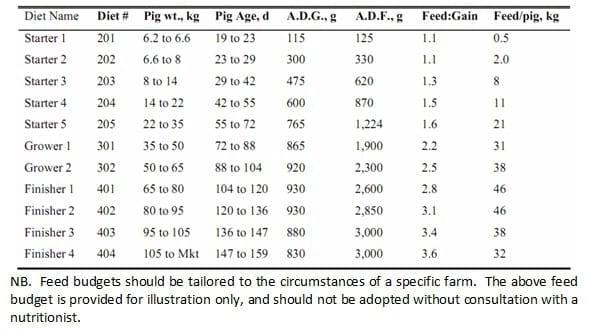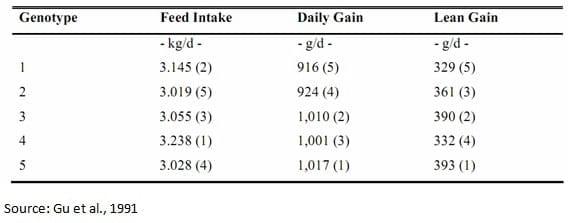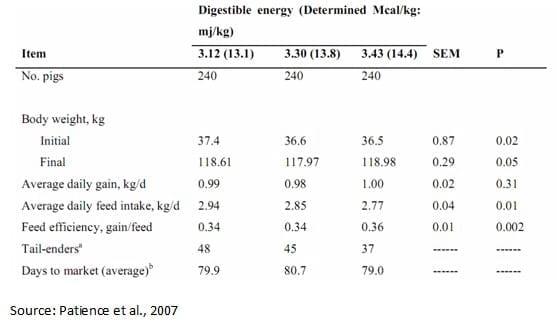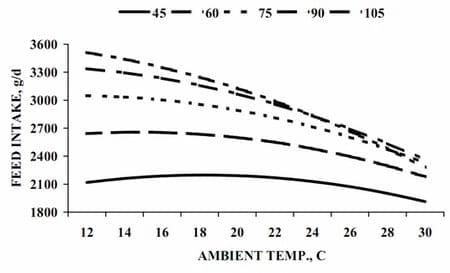Feed Intake in Pigs
Maximizing Feed Intake in Growing Pigs
Published: January 24, 2012
By: John Patience (Iowa State University)
1. INTRODUCTION
Much has been said and written about feed intake in the pig. It is therefore surprising that it remains a topic of much interest to pork producers, as we appear to be continually challenged to reach a maximum, or at least an optimum, level of feed intake on a consistent basis. However, the focus on feed intake is not surprising in that it is the ultimate driver of growth. It would be difficult to envision a farm achieving financial success without maximizing - or at least optimizing - feed intake. As an example, Dr. de Lange at the University of Guelph, using a pig growth simulation model, calculated that income per pig place is reduced by $9.50 per pig sold if feed intake is 11% less than expected. Such calculations will vary among farms, but the general conclusion is clear; feed intake drives growth rate, growth rate drives barn throughput and barn throughput drives profits.
There are situations where feed intake may not maximize. One is carcass grading systems that demand feed intake restriction in order to achieve carcass fat content targets; another is the adoption of extensive as opposed to intensive production systems, with an attendant reduction in capital costs. Because I was asked to speak on maximizing feed intake, I assume these circumstances do not apply to this audience.
When comparing performance among farms, differences in feed intake are surprisingly large. As one example, a small survey conducted in the Canadian province of Alberta in the early 1990´s revealed that feed intake varied by 35% among farms. Based on data I have seen from individual farms over the past 20 years, this degree of variation in intake is not exaggerated.
2. FEED BUDGETS
Feed budgets are estimates of the quantity of each diet that will be fed to a pig. Feeding programs are typically designed by determining the quantity of feed that will be consumed by a pig during each phase of its growth cycle. Implementation of the feeding program is then achieved by delivering a specific amount of each diet to a group (pen, room or barn) of pigs based on the quantity of feed per pig and the number of pigs being feed. Table 1 illustrates an example feed budget for a 600-sow farrow-to-finish herd weaning at 3 weeks of age and marketing pigs at 117 kg live weight.
Studying feed budgets can be an extremely useful exercise. In our experience, comparing the "theoretical" feed budget - or the one upon which the diets were formulated - against the actual feed budget - or the amount of each diet actually consumed by the herd - can be the difference between making a profit or losing money. Errors in the implementation of feed budgets can therefore reduce net income or impair pig performance or both (Table 2). It is not uncommon to see deviations between theoretical and actual feed budgets accounting for differences in feed cost per pig sold in the range of 10% or more.
More than 60% of the pig´s total feed intake will be consumed after it reaches 60 kg. Therefore, diets in the last phase of the feeding program must be carefully formulated to avoid additional and unnecessary cost while at the same time ensuring adequate nutrient intake to optimize net income.
3. FEEDING PROGRAM OBJECTIVES
As strange a statement as it may seem, the objective of the feeding program on a given farm should be clearly defined and communicated to all personnel involved. In my experience as a consultant, it is not uncommon to find three different people working ostensibly for the same farm to define three different targets for the feeding program. For example, the farm owner generally wants to see net income maximized. The nutritionist may have a higher emphasis on one or more performance indicators, such as feed conversion, because that is how he is being compared to his/her competitors. Finally, the barn manager may be concerned about a specific productivity target, such as grading, since this may be a key component of his production bonus. Clearly, in this situation, someone is bound to be disappointed with the feeding program. Therefore, the objective of the feeding program should be discussed with all people involved, and a clear objective(s) defined - and agreed upon. This can be a critical step in ensuring the success of our feeding program.
4. MANAGEMENT STRATEGIES TO INCREASE FEED INTAKE
The first step to maximizing feed intake is to measure it! The U.S. National Research Council, in their publication, Nutrient Requirements of Swine, provides an equation that estimates the daily energy intake in the pig based on body size:
DEINTAKE = 13,162 x (1 - e-0.0176BW) where BW is body weight of the pig and "e" is a constant = 2.7183. Dry matter of the feed is assumed to be 90%.
In our experience, the daily feed intake on most commercial herds falls within the range of 85% to 95% of the amount predicted by this equation. We rarely see feed intake above 105% or below 70%. This equation is helpful because it can be used as a benchmark. If feed intake is below 95%, improvement is definitely possible and if feed intake is below 85%, improvement is desirable. If feed intake is below 80% of what the NRC predicts, then the problem is likely to be very serious.
Ideally, develop a feed intake curve for your farm that defines the feed intake of pigs at different stages of growth. It is not unusual on commercial farms to identify feed intake problems at specific stages in production, or even within a stage of production. For example, a feed delivery system that is acceptable for smaller pigs may become problematic as they grow and their requirements increase. Consequently, it is extremely valuable to be able to identify where shortfalls in feed intake are occurring, as it allows more specific and effective management strategies to be implemented. Use of liquid feeding systems should make this step relatively easy.
Use the list of factors in the following sections to determine where improvement is most likely to be achieved. Focus first on 1) the most likely candidates, given the history of the herd, and 2) the factors that are most likely to have the greatest impact. In my experience, feed delivery, building ventilation and herd health are the most likely candidates - or the ones with the biggest payback - on most farms. However, herd health is also the one that is the most difficult to change.
Reassess feed intake as per item #1 and #2 above, to evaluate the response to management changes. Continue to monitor feed intake as a key and critical indicator of barn management success. Seasonal changes will become apparent and may also be corrected.
5. MAXIMIZING FEED INTAKE: The Social and Physical Environment
The pig´s physical and social environment is clearly major determinants of feed intake. Modern confinement housing systems place the onus of responsibility with respect to the pig´s comfort clearly on the shoulders of pork producers, since the pig has little opportunity to self-a more favourable environment. The use of straw, or outdoor housing, provides the pig with more latitude in this regard (shade versus sun, wet versus dry, draughty versus calm, etc).
5.1. Barn temperature
I assume this is not much of a problem in Ireland, given the climate, but keeping barn temperatures too high will obviously lower feed intake. For every ºC above the pig´s thermal comfort zone, feed intake will 40 grams per day. Bigger pigs will be affected more by heat stress than smaller pigs.
During periods of hot weather, feed intake can be enhanced by feeding diets with reduce fibre and protein content and by using sprinklers. If evenings are cool, lowering the ventilation set point by 8ºC will also increase overall feed intake.
It is generally recommended that pigs enter the grow out barn at 22 to 23ºC and that this temperature be lowered by about 1.5ºC every week until the temperature reaches 15ºC at about 55 kg bodyweight. When the ambient temperature rises above these levels, a number of actions can be taken to increase feed intake: feed a diet with reduced crude protein and fibre content use sprinkler systems to provide direct cooling of pigs and to wet the floor, thereby increasing heat loss from the pig´s body move pigs during the cooler part of the day
5.2. Social Interaction
5.2.1. Space Allocation
Floor space allowance is best expressed as a function of BW0.667; maximum feed intake occurs when floor space allowance for growing pigs is set at 0.039 m2 BW0.667. However, the economic optimum lies somewhat below this standard. Legislated or marketplace defined standards will also influence floor space allowance.
5.2.2. Regrouping
In order to maintain efficient use of barn space, regrouping of animals may be required from time to time. Regrouping may occur when pigs are weaned or move from the nursery to the grow out barn; it may also occur when pigs approach market weight and some pigs within a pen or room reach market weight while other pen or room-mates remain behind. Mixing or re-grouping of animals as they approach market weight will decrease feed intake by at least 5% to 10%.
Re-grouping pigs should not be undertaken simply to improve uniformity within a pen. Regrouping will not improve performance, and in fact will increase days to market due to the disruption which occurs during mixing. The less pigs are mixed, the better off they are in terms of overall performance. Mixing may only make economic sense when it significantly improves building utilization.
5.2.3. Group Size
The number of pigs housed within a pen will affect barn design as well as construction cost. Hence, there is growing interest in the expansion of group size to 500 animals or even more. We have known for a long time that pigs housed in very small groups (eg. 5 pigs per pen) will eat more than pigs in conventional pens housing 20 to 25 pigs. Based on the most recent research, it appears that if all other factors are equal, large group sizes (100+ per pen) will reduce feed intake by no more than 3% to 5%, as compared to 20 to 25 pigs per pen.
6. MAXIMIZING FEED INTAKE: Pig Factors
While the pig´s physical and social environment are clearly major determinants of feed intake, there are also factors intrinsic to the pig that are also important.
6.1. Genetics
The baseline feed intake for a pig will be defined by its genotype. This will dictate targets for feed intake, as genotypes do differ. However, genotypes with the greatest feed intake may not be the ones with the fastest growth rate, or the greatest lean gain (Table 3).
6.2. Barn entry weight
It is an undeniable fact that bigger pigs eat more feed. Therefore, anything that can be done to increase the size of pigs entering grow out will increase feed intake. For this reason, to solve feed intake problems on some farms, we often begin our investigations in the nursery.
6.3. Health status
Health status is one of the key factors that explain the large differences in feed intake among farms. In response to pathogens, the immune system is activated to synthesize the components of its defence mechanisms, such as cytokines. An increase in cytokine production decreases feed intake. Thus, reducing the burden of pathogens to which pigs are exposed will increase feed intake. Controlled studies have shown that poor health status can reduce feed intake by 5% to 15%, or more (>30%) in severe cases. Even moderate health problems can reduce feed intake by 5%.
7. MAXIMIZING FEED INTAKE: Diet Factors
7.1. Diet energy concentration
Feed intake is very much under the control of the nutritionist. It would be very easy for a nutritionist to increase feed intake in a herd simply by modifying the energy profile of the diet; pigs will increase their intake of a low energy diet in order to maintain constant - or at least try to maintain constant - feed intake (Table 4). In this study, feed intake increased as diet DE content decreased, but since growth rate did not change, feed efficiency went in the opposite direction. This experiment represents an excellent example of how outcomes must be based on economic factors rather than simply pig performance; if this pork producer had selected his feeding program based on feed efficiency - a common target - he would have lost money.
7.2. Ingredient quality
Recent research has shown that feed intake varies among individual barley or wheat samples. For example, feed intake varied by 21% among 4 barley samples and by 17% among 4 wheat samples (Table 5). Unfortunately, it is not yet possible to easily identify those wheat or barley samples that will maximize feed intake or growth rate, but the level of fibre may be involved.
7.3. Nutrient balance
The balance of amino acids, as well as the balance of energy in relation to amino acids will affect feed intake. Excess minerals, especially calcium, may also reduce intake. Indeed, many nutrient imbalances will impair feed intake.
7.4. Anti nutritional Factors
Many common ingredients contain anti-nutritional factors (ANF) that can lower feed intake. Soybean meal must be heated to destroy undesirable enzymes in the seed. Canola meal and field peas also contain ANF; however, if included in the diet at recommended levels, the impact on feed intake will be negligible.
CONCLUSIONS
Feed intake is an important driver of success. Because feed intake is closely linked with growth rate and feed efficiency, it is sometimes difficult to determine if the cause of problems on a particular farm are due to primary factors reducing feed intake or secondary factors that are more related to growth rate. Environmental, social and nutritional factors all play a role, as well as the character and health status of the pig. This can make solving feed intake problems a real challenge, because typically, shortfalls are the result of more than one single deficiency in the production system. Nonetheless, because improved feed intake is usually associated with increased net income, there is a strong motivation to maximize - or optimize - feed intake on a given farm.
Table 1. An example feed budget for pigs from weaning to market

Table 2. Impact of correcting error in feed budget implementation on nursery pig Performance

Table 3. Genotype effects on feed intake and growth, including relative ranking ().

Table 4. Effects of feeding diets formulated to contain 3.20 (13.4mj), 3.35 (14.0mj) or 3.50 (14.7mj) Mcal DE/kg on the performance of growing/finishing pigs on a commercial barn

a) Number of pigs not reaching market weight during the allotted experimental period.
b) Of those pigs reaching the minimum market weight.
Table 5. Effects of barley, wheat or corn source on weanling pig performance.

Figure 1. Impact of ambient temperature on feed intake of pigs of varying body weights.

This paper was presented at the Pig farmers´Conferences in Ireland 2007 and was originally published by Teagasc, Oak Park, Carlow. Engormix.com thanks the author and Teagasc for this contribution.
Related topics:
Authors:
Iowa State University
Recommend
Comment
Share
16 de noviembre de 2016
Is there an sop for using sprinklers in a finishing barn and any hard data to show that it works - thanks Dave
Recommend
Reply

Would you like to discuss another topic? Create a new post to engage with experts in the community.







.jpg&w=3840&q=75)